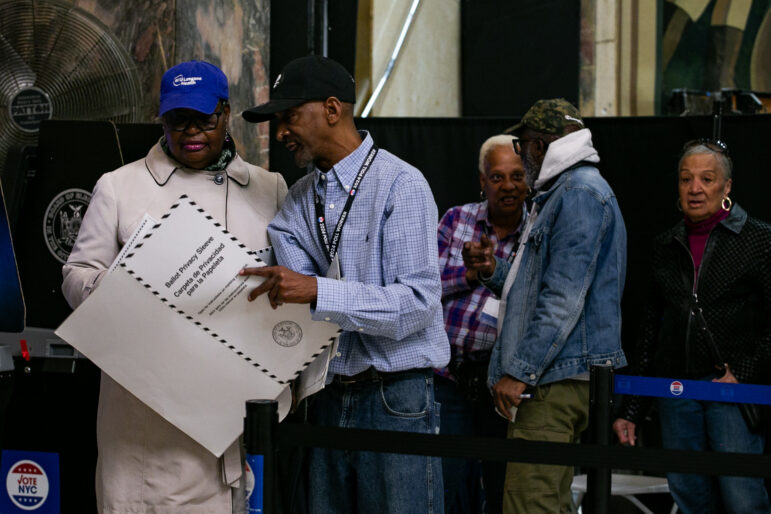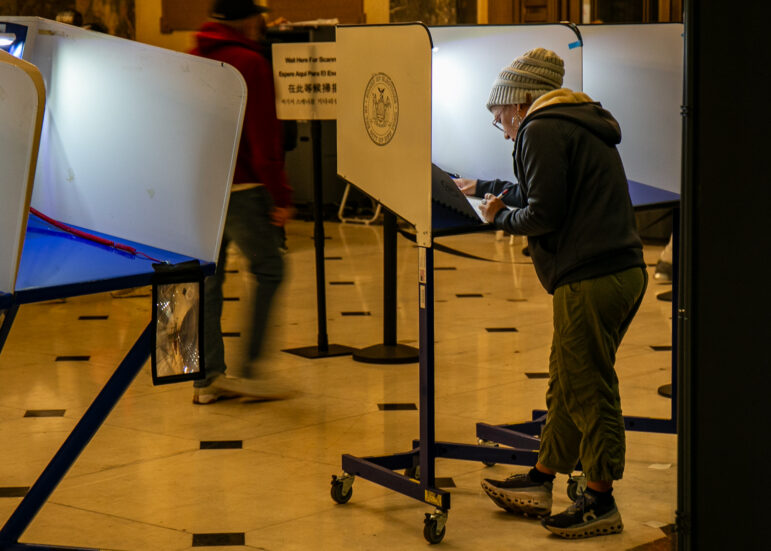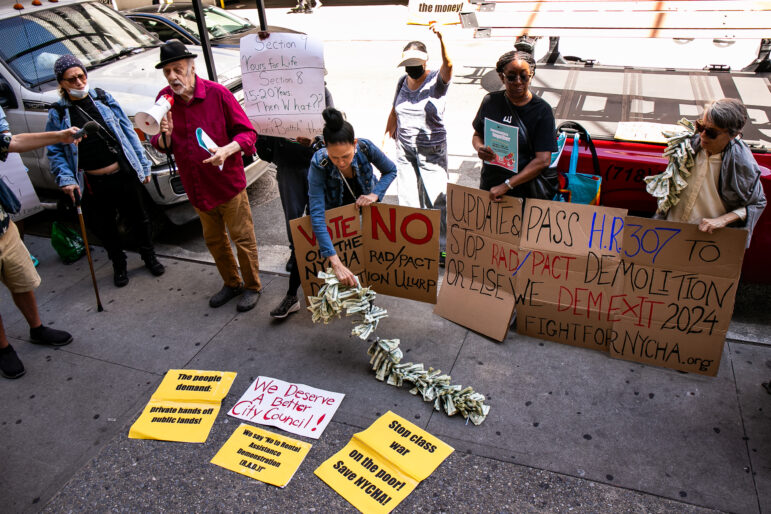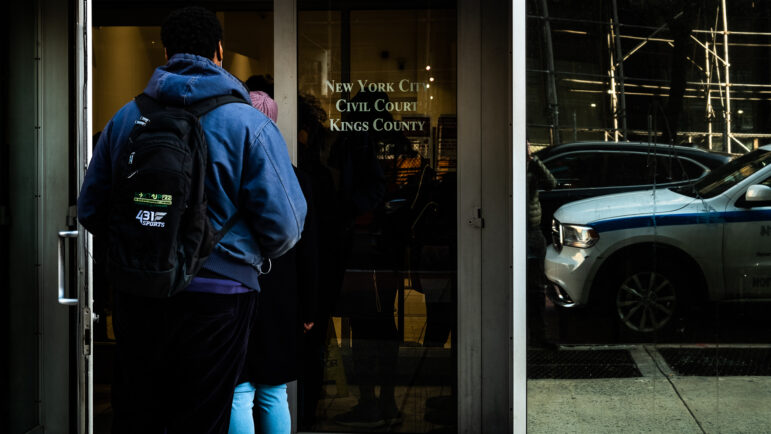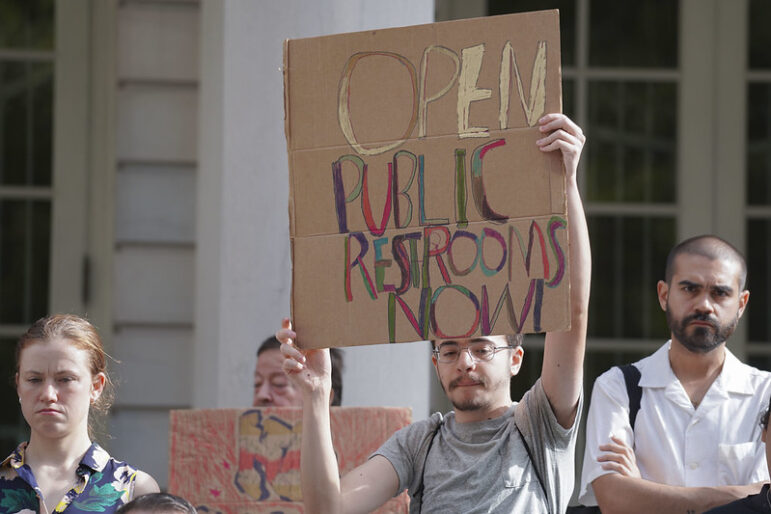
Photo by: Jarrett Murphy
Agnes Rivera, a resident of NYCHA’s Robert Wagner Houses. She understands that by selling off some of its many properties—something conservative analysts have proposed but NYCHA has not embraced—the authority would have more money to repair her apartment. But she wonders where the displaced residents would go.
Monique Bailey does not need anyone to tell her that there are sometimes problems in the projects—problems that, at first glance, might appear to confirm the harshest stereotypes of public housing. On the afternoon of Halloween, sporting her blue Tenant Patrol windbreaker, she was sitting at a card table in the lobby of her building at the edge of the Castle Hill development in the southeast Bronx. Bailey was handing out bags of candy to kids coming into the building. The candy was special, but Bailey’s presence in the lobby was not. “I sit here and watch the comings and goings,” she says. Having been in the building for 10 years, she notices changes, and they aren’t all good. “You get new tenants in. They piss in your hallway,” she says. “We never had that on the 10th floor.” The lobby itself smells slightly of urine. Music blares from a nearby apartment. “This is what I mean,” Bailey says, gesturing toward the noise. “Don’t get me wrong. I love Jessica Simpson, but I don’t need to hear your music.”
Urine in the halls was not what the founders of public housing had in mind. But by the time construction on Castle Hill was completed in 1960, the reality of public housing had evolved substantially from the founders’ ideals. In fact, from the start, those ideals were only part of the story.
The drive to improve housing for poor people has deep roots in American history, but as a legislative matter it first gained a foothold in New York City in 1867, when the original tenement code went into effect. It wasn’t that the private market didn’t provide housing for poor people. It was that the housing was atrocious. This is reflected in the law itself, which set out the not exactly sweeping goal that every room have a window. An only slightly more ambitious 1879 law mandated that each building have at least one toilet for every 20 residents. In 1901, the law was again strengthened to require toilets in every apartment and less-dense construction. But that’s where the progressive era stopped: Government would regulate housing, not build it.
That reticence to allow government to actually build housing only receded in a war economy. In 1917, the United States entered World War I and suddenly needed lots of bombs and bullets—along with the workers to make them. Defense factories had to find a way to house all the extra help, so in 1918, Congress set up the U.S. Housing Corporation to build temporary housing for new defense workers who had moved closer to factories. As the war neared an end, the housing need for these workers was pegged at nearly 300,000 houses, although only 6,000 homes were built. Yet aversion to this kind of government intervention was so sharp that as soon as hostilities ceased, Congress hounded the USHC to sell all of its stock and get out of the housing business, which it ultimately did.
It wasn’t just that Congress was worried about “socialism.” The antipathy went deeper—it was rooted in an American ethos that honored individual achievement, idolized the single-family home and distrusted the poor. “Americans, unlike the Western Europeans, resisted much longer than anybody else who had the resources the notion of putting significant, deep government subsidies into housing,” says Lawrence Vale, an M.I.T. professor and public housing historian. “It really took the impetus of the Great Depression to force the issue, and there the justification occurred not so much because it was seen as a human crisis but part of a job-creation scheme.”
In 1934, the federal government approved the use of public works funds for a limited program of public housing. Three years later, Congress acted more broadly, creating a federal housing entity to lend money to local authorities for the construction of public housing. This was the move that established a long-term federal role in such housing. The bill’s backers pitched it as an antidote to market failure. “Private enterprise alone can make no profit by providing the kind of housing that millions of people need if they are to be decently housed,” said Senator Robert Wagner, one of the sponsors.
But resistance to government involvement in the housing market had hardly disappeared. The 1937 Housing Act required that, under most circumstances, any public housing merely replace housing that had been demolished—so there would be no overall increase in the housing supply. And it restricted eligibility to extremely poor people—those who couldn’t possibly afford a private-market apartment—meaning that public housing would not vie with the private sector for tenants. While a few historians blame these measures on well-meaning progressives, most believe that they are the product of an effort to, from the outset, constrain public housing to protect private industry from competition.
During World War II, the emphasis in federal housing policies shifted back to constructing homes for defense workers. When the federal government got serious about building public housing again after the war, it was in the name of “slum clearance,” the wholesale demolition and revamping of urban neighborhoods. Public housing was supposed to replace the homes that were eradicated under the Housing Act of 1949. In reality, the number of units produced fell short of this goal, in part because the Truman administration cut housing funding during the Korean War. Those units that were created—often in isolated and racially segregated buildings—were now reserved exclusively not just for poor people but for the very poor people who had been displaced by the clearances.
This is when the trouble began for public housing. Many projects around the country started to struggle as financial problems and design flaws made it harder to serve an increasingly needy population.
But a revitalized political animosity toward public housing emerged even before the problems at the projects became commonly known, as real estate interests began mobilizing against new public housing. According to historian D. Bradford Hunt, in 1950 the National Association of Home Builders started distributing ads that asked “Can you afford to pay someone else’s rent?” to chapters around the country. In 1951, a political war erupted in Los Angeles over whether to permit a federal housing project, with opponents labeling housing supporters “communists”; in the end, the housing was blocked. In 1960, candidate John Kennedy supported building more public housing. But by 1961, Jane Jacobs was criticizing the planning of the urban renewal and the previous decade’s public housing projects. In the twilight hope of the Great Society, Lyndon Johnson said he wanted to build 6 million units of low- and middle-income housing over 10 years. But his successor, Richard Nixon, effectively ended federal construction of housing. In 1972, with the blessing of the feds, St. Louis housing officials blew up part of the Pruitt-Igoe housing complex, which had become so overrun with crime that it was deemed unlivable. The rest of Pruitt-Igoe came down by 1975.
Pruitt-Igoe was designed by Minoru Yamasaki, who also designed the World Trade Center. That was in New York City, where things were different.
When the federal government began funding public housing in 1934, New York City led the way. The city was so eager to build housing that it moved even before federal funds were available, setting up its own housing authority (with a socialist on the board), which completed First Houses on the Lower East Side—the first public housing in America—in 1935. The feds’ driving concern may have been job creation, but Mayor Fiorello La Guardia had greater ambitions. “If there is one thing I hope to do before my time is up,” he said, “it is to give the people of my city, in place of their tenements, decent, modern, cheerful housing with a window in every room and a lot of sunshine in every window.” The need for such housing was undeniable: 3,000 people joined the waiting list for the 119 apartments in First Houses. Eighty-one of the families who moved in came from apartments that lacked heat and toilets.
Federal money soon flowed in to build the Williamsburg and Harlem River houses. But the New York City Housing Authority continued to chart an independent course. Even in the 1930s it resisted pressure from the federal government to offer public housing only to the poorest people, even going so far as to build state- and city-funded housing in order to escape some of Washington’s dictates. University of Michigan housing historian Roy Strickland says the criteria for getting into New York’s public housing were singularly strict. You had to be a citizen, have a bank account and insurance, and earn enough that you’d probably not be considered poor. Housing officials visited applicants’ apartments to see if they were clean, dirty or even “filthy.” Those who made the cut, Strickland says, “were an elite group of working-class people.” By selecting desirable tenants, NYCHA made managing the projects easier.
The people running the authority were also well suited to it. “In Chicago and Washington, D.C., many cities, it was just a cesspool for nepotism and patronage. It was not taken seriously,” says Alex Schwartz, a New School professor who has studied public housing. “It wasn’t well maintained. New York City was much more judicious in terms of managing the housing.” This is probably a major reason that New York’s public housing is widely considered the best managed and most successful in the country.
Public housing in New York also drew on a number of built-in benefits. Federal cost limits meant that a lot of public housing around the country was built in high-rise buildings. In many towns and cities, that represented a sharp break with how most residents lived. In New York, however, it was natural— hundreds of thousands of New Yorkers lived in high-rises, and there was a class of managers and tradespeople skilled at running and fixing such buildings. A good mass-transit system meant that it was feasible to locate many public housing developments near subway stops, or at least along bus lines, helping New York’s housing avoid the isolation that vexed projects in other cities. Even Robert Moses, whose sweeping slum clearance projects housed a mere fraction of the people they displaced, wanted public housing to be close to transportation.
Still, even in those early days, NYCHA started to see some of the financial problems that would eventually cause extensive damage to public housing in other cities. While public housing was envisioned as self-sustaining, with rents covering operating costs, NYCHA warned as early as 1938 that “serious thought must be given to the question of securing a permanent income to support Authority activities which cannot be properly taken out of the rent paid by low income tenants.” In NYCHA’s 1964 annual report, the declaration was starker: “With the exception of certain [city-funded] projects, income from rents is insufficient to meet operating costs and debt service.”
As NYCHA began to face the financial reality of low rents, it also had to contend with sweeping social change among its tenants. In 1953, NYCHA updated its already exacting entry requirements to include 21 factors that counted against an application, according to Nicholas Dagen Bloom, a New York Institute of Technology professor who recently published a masterful history of public housing in New York. These factors included being a single mother, having a child with mental retardation and not having furniture. These rules came about, Bloom says, “because there was this sense that public housing might become socially unmanageable.”
But in the 1960s, “there was enormous pressure on NYCHA,” Bloom says, to admit poorer people, single mothers, welfare recipients and others whom the authority had avoided housing. The Welfare Department’s hotels were overbooked and costing the city a lot of money, so Mayor John Lindsay’s administration pressed NYCHA to alter its selection criteria. “In 1968, they basically changed the rules and almost immediately, the welfare percentage doubles to 35 percent,” Bloom says. Vandalism and crime increased, he says: In 1972, NYCHA replaced 188,000 panes of glass; in 1974, it spent $3 million to remove graffiti.
At the same time, New York and housing authorities around the country were seeing costs rise rapidly. Congress responded by passing the Brooke Amendment in 1969. This capped rents that could be charged for public housing at 25 percent of a tenant’s income—preserving af fordability but also limiting NYCHA’s revenue stream. Congress created a subsidy to help make up the difference, but—as would become painfully clear during the recent Bush administration—that put public housing at the mercy of annual appropriations decisions.
NYCHA weathered the changes of the ‘60s and ‘70s better than most authorities around the country. In 1979, the U.S. Department of Housing and Urban Development completed a comprehensive nationwide survey of public housing and found that 45 percent of its housing units were “troubled” or “somewhat troubled” mainly because of “the shift in tenant population from two-parent, working-class families to singleparent, welfare tenants.”
NYCHA, however, benefited from certain demographic bulwarks. The tight housing market in the city meant there was consistent demand from moderate-income people for public housing; that made it easier for NYCHA to attract customers who could pay more rent. It took changes in federal rules and significant local political pressure to force NYCHA to open its doors to the homeless in the 1980s, and the authority quickly moved back to favoring the higherincome working poor in the 1990s.
Through it all, NYCHA managed to avoid the disasters to which other housing authorities fell victim. “By and large there’s a much more positive view of public housing in New York because they don’t have the buildings that Chicago or New Orleans had,” says Joseph Shuldiner, a veteran of NYCHA, HUD, and housing agencies in Los Angeles and Chicago who now runs Yonkers’ housing agency. That success has given NYCHA standing, he adds. “I believe that politically, the authority was protected more than it would have been anywhere else.”
To some critics of public housing, however, New York’s success is not apparent.
“Across the country, far-sighted political leaders are destroying public housing projects…. The failed vision of government-run housing projects is being demolished in a puff of concrete dust,” read a 2002 editorial in the now-defunct New York Sun; its authors wondered why New York City wasn’t following suit. They aren’t alone. For some critics, the failure of public housing is so manifest that New York’s experience offers no counterpoint.
“Everyone knows how quickly these housing projects, particularly in big cities, turn into dangerous, demoralized slums,” writes Howard Husock, probably the nation’s most passionate critic of public housing, in his 2003 book America’s TrillionDollar Housing Mistake. In the book, Husock (whom the Bush administration appointed to a HUD rule-making committee) argues that public housing fills “a nonexistent need … a fictional scarcity of affordable housing for poor people.” Until the New Deal, Husock writes, “the private housing market generated a cornucopia of housing forms to accommodate those of modest means…. True, many lived without hot water or their own bathroom. But rents were cheap.”
“In New York City the sheer quantity of property locked into service as public housing is a significant drag on the city’s economy,” argues Husock, who is based at the Manhattan Institute. Public housing distorts society’s system of carrots and sticks because “housing subsidies do not reward achievements, they reward need.” And it “concentrates together welfare dependent, single parent families whose fatherless children disproportionately turn out to be school dropouts, drug users, nonworkers and criminals.”
Husock even takes issue with the names of NYCHA developments, like Borinquen Plaza or Langston Hughes Houses. In his mind, these names “suggest that the racial makeup will always be the same”—Puerto Ricans in one, blacks in the other.
Or, you know, the Thomas Jefferson Houses in East Harlem. That place is overflowing with Southern aristocrats.
What opponents of public housing often ignore is that almost all housing in America is subsidized. The government launched Fannie Mae, Freddie Mac and Ginnie Mae to create a more robust mortgage market. Governments on all levels have provided subsidies for mass transit and highways to transport people to their homes in the burbs. The federal tax deduction for mortgage interest cost the U.S. Treasury at least $67 billion in 2008, or about 17 times as much as the feds spent on public housing.
Seventy years of homeownership promotion hasn’t put housing within the reach of poor and moderate-income people living in New York City. According to a recent report by the Citizens Housing and Planning Council, the median rent burden of the poorest third of city residents increased from 50 to 57 percent of their household income between 1991 and 2005. Forty percent of New Yorkers live in apartments that are too small or too expensive for them. Simply put, this is what market failure looks like.
Far from being a drain on the city’s economy, says the New School’s Alex Schwartz, public housing was, “during the worst years of widespread disinvestment and abandonment … basically the only area of some of these communities that remained intact, and it really helped provide some measure of stability in neighborhoods that were otherwise utterly devastated. They provided sort of a nucleus for development later on.”
The condos rising near NYCHA developments in Fort Greene and East Harlem hint at this dual role for the projects. They were anchors during bad times and are now refuges from the high rents of the boom years. Anne Washington, who raised five children in the Grant Houses in Harlem, moved in 31 years ago. At that time, she recalls, everything was burned-out but the projects. Now the neighborhood is hot—and housing is still out of reach. When she and her family moved in, they said, “OK, it’s just temporary, two years tops,” she recalls. “I wanted to get out of here. But where could I go? Rents kept getting higher and higher, and I decided to stay in public housing.” Now her son, who moved out but is being priced out of his current neighborhood, is considering coming back.
Many of NYCHA’s residents are people who might have a hard time finding housing that works for them in the private market. Some 36,000 NYCHA residents are senior citizens living alone. About a quarter of the people who enter NYCHA housing each year are disabled. And NYCHA apartments represent 8.3 percent of the rental supply in New York City, a key counterweight to the ups and downs of the private market. “In a city with extreme scarcity of low- and even moderate-income housing, it’s a precious resource,” Schwartz says. “People who are currently in it would be competing with everyone else for affordable housing. Without public housing the city would be even more of a bastion of wealth.”
That public housing has worked better in New York than elsewhere, and that it plays an important role here, doesn’t mean that it was or always is a very nice place to live. Lisa Burriss, an organizer for Public Housing Residents of the Lower East Side, grew up in public housing, and her mother still lives there. “I went to P.S. 110. What surrounds P.S. 110 are [private] co-ops. Then you had the public housing that surrounds the same school,” she recalls. “We saw the differences when we went on trips. We would wait in each other’s building sometimes. You could see the difference in the lobby. Our mailboxes were in there, so a lot of times they got broken into. A lot of crime. A lot of drug traffic. The kids that live in those other buildings had better opportunities.”
The difference between public housing and the rest of the housing market has always been accentuated by the projects’ design. They were often built in “superblocks” that eliminated cross-streets, lacked commercial activity and included vast amounts of open space. In a city where every block seems to boast a bodega or a deli—or both—the projects often stand out for how far you have to walk to buy a cup of coffee. Hindsight makes it easy to see how these features help isolate and, in some cities, doom public housing. But at the time they were built, the projects often reflected the architectural fads of the day. Cost also forced planners to economize, building highrise rather than townhouse projects, for example. And often, the design of public housing betrayed an excessive optimism about what the housing would do. If the early argument for public housing had a fatal flaw, it was the belief that simply providing a roof and four walls would transform lives. “The idealism of public housing advocates,” wrote architecture critic Alexander von Hoffman in 1996, “has often taken the form of environmental determinism, a belief that an ideal or improved residential environment will better the behavior as well as the condition of its inheritance.”
It wasn’t that simple, of course. And the environment was rarely ideal. Instead, in many cities, public housing probably helped keep America segregated, as public housing authorities located projects and assigned tenants in ways that encouraged racial division—although white flight also contributed to the racial polarization of many cities.
Public housing also led to concentrated poverty. Most of the poorest census tracts in New York are the locations of public housing complexes. Concentrated poverty is widely believed to be associated with higher crime and deeper economic isolation, although sometimes the cause-and-effect relationships are complicated. A recent study by NYU’s Furman Center for Real Estate and Urban Policy found that students who live in NYCHA housing perform substantially worse in school than demographically similar peers who don’t live in public housing, although the authors were unable to explain exactly why.
So the nightmarish picture that opponents of public housing paint is not pure fantasy. “Like most stereotypes, it was based in some truth,” says Barbara Sard, an expert on public housing at the Washington-based Center on Budget and Policy Priorities. But that truth has limits. “It was never true that most public housing was in very large projects, in very poor neighborhoods and badly managed,” Sard says. “That was never true for public housing as a whole, but that was its public face all too often.”
Disasters like Cabrini-Green, the notorious failed project in Chicago, contributed to that image—and to a radical shift in federal housing policy. In 1992, the National Commission on Severely Distressed Public Housing reported that of the country’s 1.4 million public housing units, about 6 percent—some 86,000 apartments—were “distressed.” This report prodded HUD to launch the Hope VI program, which allowed housing authorities to apply for money to redevelop their projects. The program took its name from an earlier HUD program, Home Ownership for People Everywhere.
At first, Hope VI was a modest program. When President Clinton came to office in 1993, however, his HUD secretary Henry Cisneros called for even more freedom from federal rules that had prevented the privatization or destruction of public housing. When the Republicans took over Congress in 1995 and targeted HUD for elimination, “reform” went even further: The next year, the Clinton administration said it envisioned some 100,000 public housing units being demolished. The Quality Housing and Work Responsibility Act of 1998 eliminated federal preferences for needy populations, imposed minimum rents on the poorest residents and allowed housing officials to let wealthier applicants skip ahead of poorer ones on waiting lists in order to “deconcentrate” poor people. Taken together, the message to local authorities was to eliminate public housing units and invite less-poor people to live in what replaced it, albeit in the name of improving life for the poor.
About 200,000 units—equal to NYCHA’s stock and then some—have disappeared nationwide since 1995. Barely half were replaced with new public housing or section 8 vouchers that subsidize private apartments for low-income people. Many of the lost units were truly distressed. Some were not.
In 2000, Harvard University’s Ash Institute for Democratic Governance and Innovation gave Hope VI an “Innovations in American Government” award, declaring that Hope VI housing “addresses the social, economic, and educational needs of residents and helps move families to self-sufficiency…. The impact on residents of public housing has been striking.” Actually, very little is known about Hope VI’s impact. HUD has never produced a comprehensive analysis of whether the program has actually worked. The few studies that have been done paint a mixed picture. Many residents report living in better housing and in lower-poverty neighborhoods, but racial segregation has not improved, and those who left public housing often say they have struggled paying rent; some have had to double up. A 2003 report by the Urban Institute concluded that “there is substantial evidence that the original residents of Hope VI projects have not always benefited from redevelopment, even in some sites that were otherwise successful,” although it recommended the program continue because of the positive impact its has sometimes had. Others are less sure there’s been a benefit. A major concern, says National Low Income Housing Coalition executive director Sheila Crowley, is that “Hope VI has caused massive displacement.”
Just as it avoided the poor management that characterized much of the history of public housing nationwide, NYCHA has also largely stood apart during the Hope VI era, undertaking only two Hope VI projects. One is at the former Arverne and Edgemere houses in Queens; it involves renovating—but otherwise leaving intact—public housing. That project is almost complete, according to HUD. Another, to redevelop the Prospect Plaza projects, is half finished. The 369 public housing apartments have been vacated, and 37 private homes have been built. But a second phase that was supposed to replace most of the lost public housing has stalled. According to HUD, “the remaining phases of revitalization work are still on the drawing board due to the many challenges associated with producing affordable housing, including the rapidly increasing costs of construction and development in the New York City market.”
Nationwide, the Hope VI era is ending; the program’s funding stream has dwindled in recent years. Still, municipalities like Salt Lake City, Las Vegas, and Columbus, Ohio, are considering sweeping reductions to their own stock because of recent federal policy—not one of demolition, as in the 1990s, but one of disinvestment.


